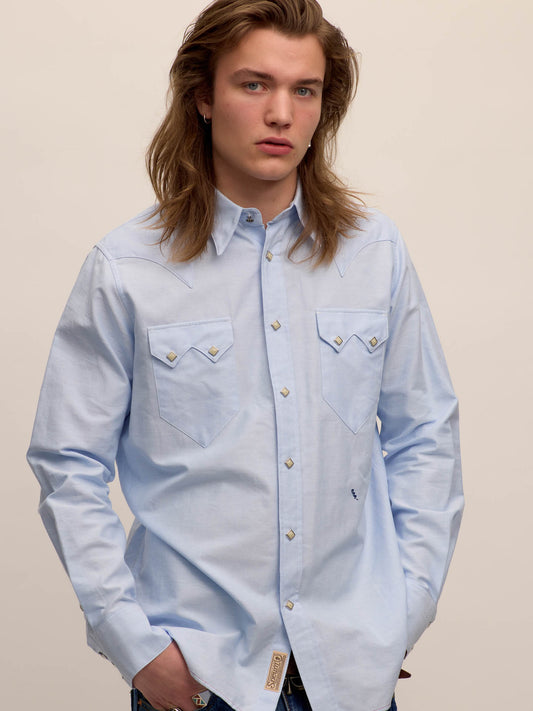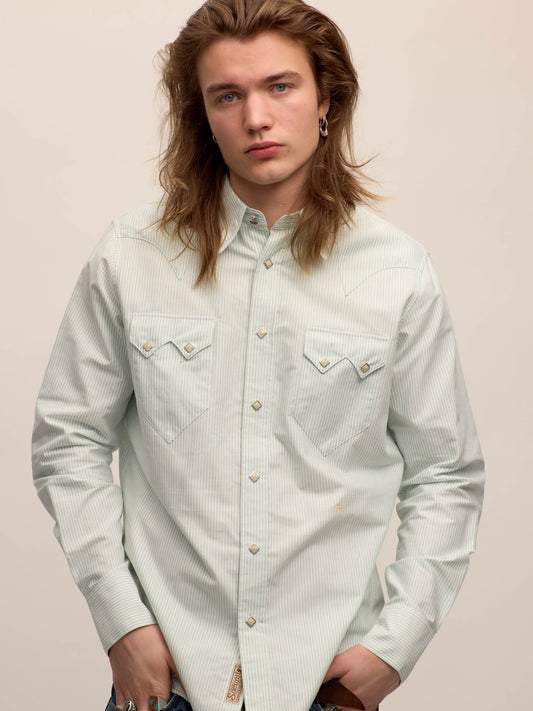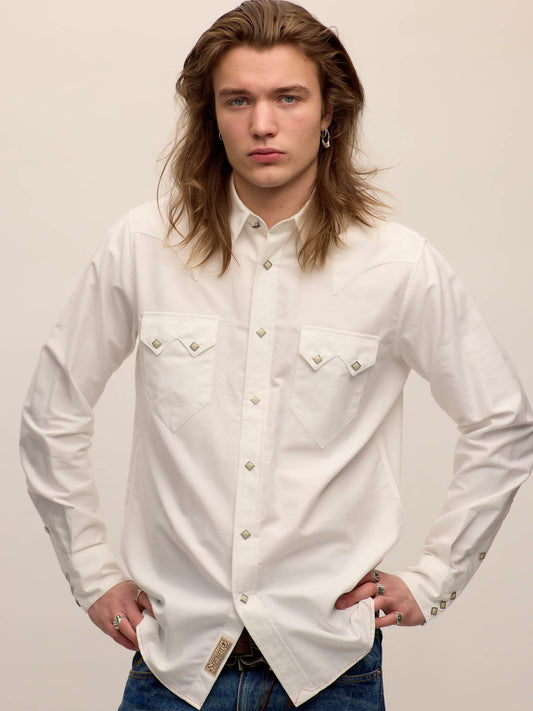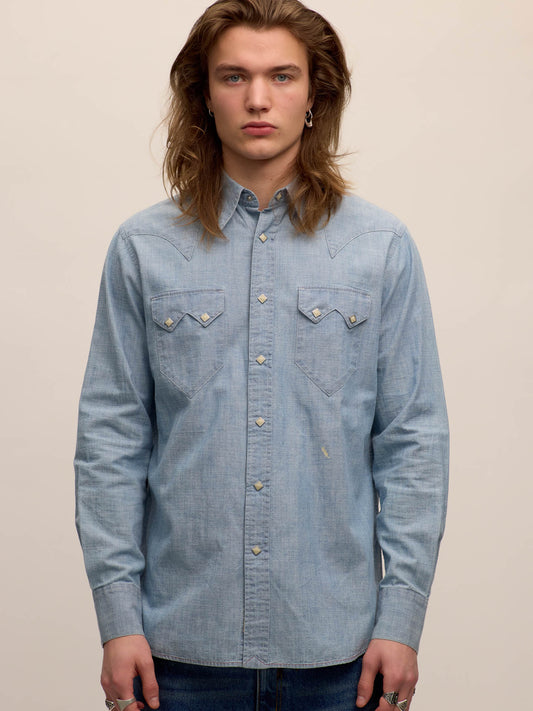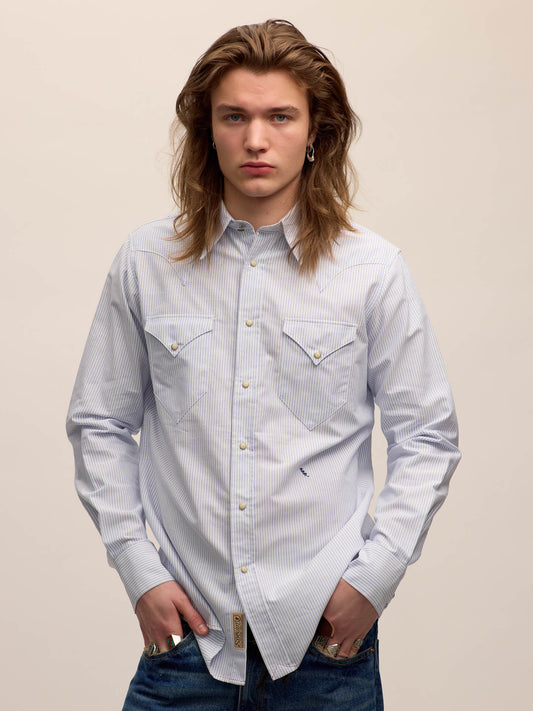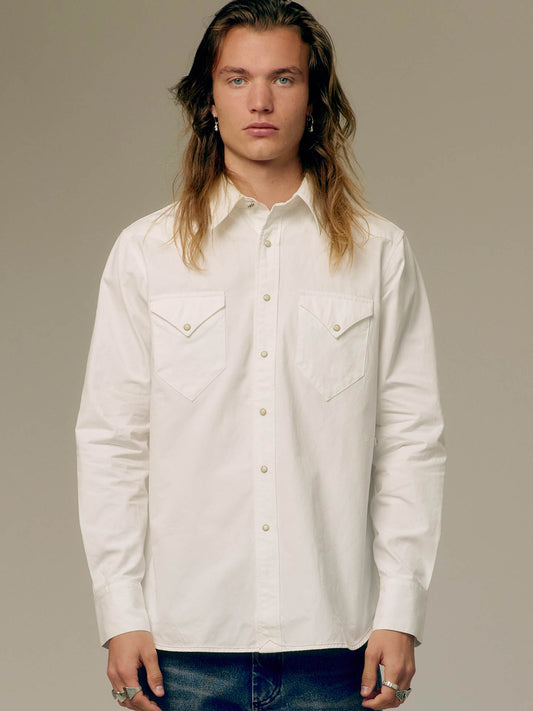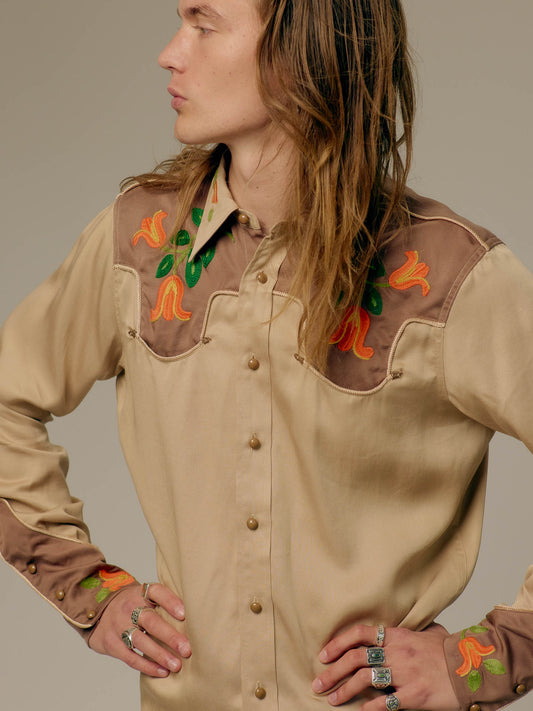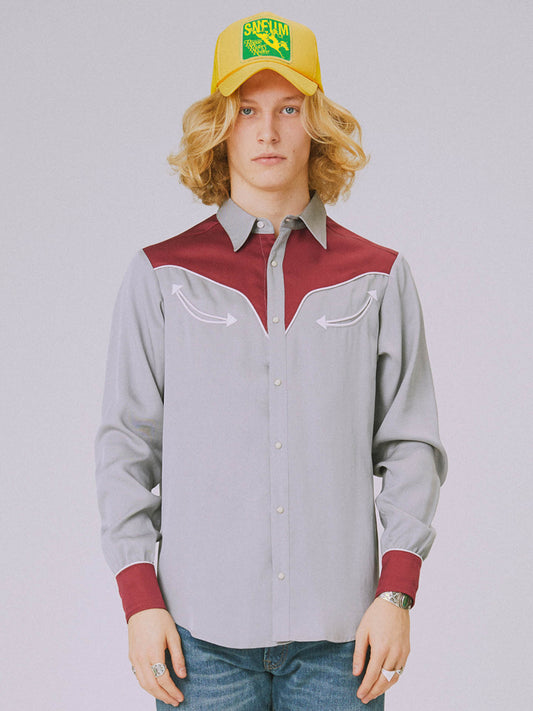The Anatomy of the Western Shirt: A Study in Design, Functionality and Evolution
The Anatomy of the Western Shirt: A Study in Design and Functionality
The Sneum® range of Western shirts represents the culmination of years of in-depth research into the history and anatomy of the Western shirt, with the goal of identifying its key distinguishing design elements. In other words, what makes the Western shirt stand out in contrast to conventional shirts? By clearly establishing these key design elements and pairing them with a historical perspective, we are able to present our own contemporary interpretations of this cultural icon.
Several signature features set the Western shirt apart from its conventional counterparts, including pointed yokes on the front and back, longer tails, dual chest pockets with pointed flaps, pearl-snap closures down the front placket and cuffs. By highlighting these elements, we aim to inject a stronger impact and contemporary appeal into the Western shirt while simultaneously honoring the rich heritage upon which they are based.
The range of shirts we offer accentuates these quintessential design elements: pointed yokes, longer tails, dual chest pockets, pearl-snap closures, and cuffs, among others. These elements were originally conceived for practical, utilitarian purposes. For instance, a lone rider on the range wouldn’t need to carry needle and thread to replace a button because of the snap closures (Schaffer, 1986). The chest pocket flaps secured items such as a tobacco tin, preventing them from falling out while riding (Lawrence, 1992). The yokes added durability through their double folds, while the snug fit prevented the shirt from snagging on saddle horns or barbed wire. Finally, the extra-long tails helped keep the shirt tucked neatly into jeans (Weil, 1993).
Though there is considerable diversity within the Western shirt style paradigm, some common design elements can be established. These include:
- Dual chest pockets, either with flaps or in the smile pocket version.
- Signature pointed yokes on the front and back.
- Cuffs in either barrel construction (three-snap closure) or shotgun cuffs (five-snap closure).
- Snap buttons on the front placket, cuffs, and pockets.
- Piping to emphasize the yoke design, front placket, cuffs, and collars.
Not all Western shirts feature every element listed above simultaneously. For example, smile pockets, piping, and shotgun cuffs are often grouped together, while flap chest pockets typically feature barrel cuffs and rarely include piping (Miller, 2001).
Our research has led us to classify Western shirts into three main categories, which can be further divided into subclasses. Although many variations of Western shirt styles have existed over time, we regard these categories as foundational pillars:
- Flap Pocket Western Shirts
- Single-point pocket Western shirts
- Sawtooth pocket Western shirts
- Slant pocket Western shirts
- Smile Pocket Western Shirts
- Plain smile pocket Western shirts
- Two-tone smile pocket Western shirts
- Bib Front Western Shirts
As evident from this classification, Western shirts are often named based on their chest pocket styles. Jack Weil of the Rockmount Ranchwear Company once remarked, “Pockets in Western shirts are like the grill on a car: they define the shirt more than any other element” (Weil, 1993). Therefore, the naming convention of Western shirts typically links to pocket types. Broadly speaking, pockets in Western shirts can be reduced to two basic types: the snapped flap pocket or the smile pocket version. Additionally, the bib-front shirt, which has no pockets, occupies a distinctive place in Western shirt design (Smith, 1998).
Unpacking the Structural Hallmarks of Western Wear
While the anatomy of the Western shirt is defined by its distinguishing features—pockets, yokes, cuffs, and buttons—it is the historical evolution and practical applications of these elements that have shaped the shirt into the iconic garment it is today. The following sections delve deeper into three key components that have played pivotal roles in the Western shirt’s development: the yoke, the cuff, and the transition from shank buttons to snap buttons. Each of these features has its own unique history and design typologies that contribute to the functional and stylistic integrity of the Western shirt.
We begin by exploring the yoke, followed by an examination of cuffs. Lastly, we trace the transition from traditional shank buttons to snap buttons, a pivotal innovation that came to define the Western shirt. It is the sum of these parts that represents the structural backbone of the western shirt.
- The Western Yoke in an Evolutionary Perspective: Historical Background and Design Typologies
The yoke is one of the most distinctive design features of the Western shirt, and its origins are rooted in both function and aesthetics. The yoke refers to the shaped section of fabric across the shoulders, both on the front and back, which provides structure to the garment.
Historical Background
Yokes were first introduced to Western shirts in the late 19th century as a practical feature to reinforce areas of stress, particularly for those engaged in labor-intensive activities such as ranching and horseback riding (Carter, 1987). Cowboys and ranchers needed shirts that could endure harsh environments, and the yoke's double layer of fabric across the shoulders offered added protection against friction and strain. By the early 20th century, the pointed design of the Western yoke emerged as a stylistic hallmark, particularly with the influence of manufacturers such as Levi Strauss and Rockmount Ranchwear (Weil, 1993).
Design Typologies
Western yokes vary in design, but the two most common variations are the single-point yoke and the double-point yoke. The single-point yoke is typically found on the front of the shirt, with a clean and minimalist design, while the double-point yoke adorns both the front and back, providing a more ornate appearance. Some Western shirts also feature embroidered yokes or contrast stitching, further accentuating this structural element.
- Western Cuffs in an Evolutionary Perspective: Historical Background and Design Typologies
Western cuffs are an essential element in Western shirt design, combining both functionality and style. These cuffs evolved from practical necessity, protecting the wrists during physically demanding tasks, to become a stylistic feature now associated with the rugged yet elegant aesthetic of Western wear.
Historical Background
Western cuffs originated in the late 19th century, driven by the need for durable, adaptable clothing that could withstand the rigors of ranch life and cattle drives. Early Western shirts, often influenced by military designs, featured barrel cuffs that could be tightly fastened to protect the wrists and forearms from dirt, debris, and injuries (Smith, 1998). Cuffs also served a practical purpose by making it easier to adjust sleeves depending on the weather or the work being performed.
By the early 20th century, Western cuffs began to evolve alongside the burgeoning popularity of rodeos and Western films. These cultural phenomena transformed utilitarian elements into markers of style. The cuffs, once simple and unadorned, started incorporating decorative features such as piping, contrast stitching, and snap buttons. The use of snaps was particularly convenient for cowboys who needed to make quick adjustments while riding or working (Lawrence, 1992).
Cuff Typologies
There are two primary types of Western shirt cuffs:
- Barrel Cuff: The most common cuff style, the barrel cuff is straight and secured by two or three snaps. Its simplicity and durability made it a favorite for working cowboys. Over time, barrel cuffs were adorned with decorative piping and embroidery to enhance their visual appeal.
- Shotgun Cuff: A more elaborate style, the shotgun cuff extends further up the forearm and features as many as five snaps. This extended length provided additional protection for cowboys during labor-intensive tasks, while also becoming a canvas for decorative elements such as contrast stitching or elaborate embroidery (Miller, 2001).
- The Transition from Shank Buttons to Snap Buttons: Practical Necessity and Cultural Evolution
The adoption of snap buttons on Western shirts marked a significant shift in design and functionality, driven by both practical and cultural factors. Snap buttons, which were initially introduced in the late 1940s, soon became an iconic feature of Western shirts.
Historical Background
Before the advent of snap buttons, most Western shirts used shank buttons, which were often made from bone, metal, or plastic. These buttons, while sturdy, were time-consuming to fasten and could easily break or fall off during rigorous work. Snap buttons provided a more durable, efficient alternative.
During World War II, the transition to snap buttons was partially fueled by material shortages. The war effort led to a significant reduction in the supply of shank buttons, as raw materials such as metal and plastic were prioritized for military use (Schaffer, 1986). As a result, manufacturers sought alternative solutions, with the Scovill company emerging as a key player in the development and production of snap buttons. Originally used in military uniforms, Scovill's snap buttons were soon adopted by Western wear manufacturers like Rockmount Ranchwear, as they offered a practical solution to material shortages while also being quick and easy to fasten (Weil, 1993).
Why the Transition Happened
Aside from material shortages during WWII, snap buttons became favored for their practical advantages. Unlike shank buttons, snaps allowed for faster dressing and undressing, a critical factor for cowboys on the range. Snap buttons also provided an added safety feature, as they could quickly release if caught on equipment or livestock (Smith, 1998). This functionality, coupled with the rising popularity of rodeos and Western films, cemented snap buttons as a symbol of rugged, modern Western wear (Miller, 2001).
References
Carter, B. (1987). The Design Evolution of Western Apparel. Austin: University of Texas Press.
Lawrence, M. (1992). Utility Meets Fashion: The Evolution of the Western Shirt. Journal of American Fashion History, 14(2), 50-58.
Miller, J. (2001). Western Shirt Styles Across the Ages. American Design Quarterly, 7(3), 21-28.
Schaffer, C. (1986). Western Wear: The American Cowboy Icon. New York: Outback Publications.
Smith, A. (1998). Ranchwear in the American West. Chicago: Western Heritage Press.
Weil, J. (1993). The Story Behind the Snap: A Ranchwear Evolution. Denver: Rockmount Publishing.
Western shirt pocket typology
Western shirt cuff typology
Sawtooth western shirts
-
Sawtooth western shirt in light blue oxford
Regular price 200 EURRegular priceUnit price / per -
Sawtooth western shirt in green striped oxford
Regular price 200 EURRegular priceUnit price / per -
Sawtooth western shirt in white oxford
Regular price 200 EURRegular priceUnit price / per -
Sawtooth western shirt in chambray
Regular price 200 EURRegular priceUnit price / per
Single point western shirts
-
Single point western shirt in blue striped oxford
Regular price 200 EURRegular priceUnit price / per -
Single point western shirt in white poplin
Regular price 200 EURRegular priceUnit price / per
Smile pocket western shirts
-
Two-tone smile pocket western shirt
Regular price 200 EURRegular priceUnit price / per -
Smile pocket two-tone western shirt w. floral embroidery
Regular price 270 EURRegular priceUnit price / per -
Two-tone smile pocket western shirt
Regular price 95 EURRegular priceUnit price / per190 EURSale price 95 EURSale
